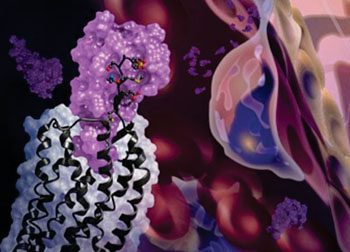X-Ray Crystallography Study Reveals Structure of the Chemokine Receptor CXCR4 in Complex with a Viral Ch
By LabMedica International staff writers
Posted on 02 Feb 2015
The crystal structure of the protein complex created by the binding of the cellular receptor CXCR4 (C-X-C chemokine receptor-4) to its ligand has been solved by exploiting the binding characteristics of the viral chemokine analog vMIP-II.Posted on 02 Feb 2015
CXCR4 is an alpha-chemokine receptor specific for stromal-derived-factor-1 (SDF-1 also called CXCL12), a molecule with potent chemotactic activity for lymphocytes. This receptor is one of several chemokine receptors that HIV can use to infect CD4+ T-cells. During embryogenesis CXCL12 directs the migration of hematopoietic cells from fetal liver to bone marrow and the formation of large blood vessels. In adulthood, CXCL12 plays an important role in angiogenesis by recruiting endothelial progenitor cells (EPCs) from the bone marrow through a CXCR4 dependent mechanism. It is this function of CXCL12 that makes it a very important factor in carcinogenesis and the formation of new blood vessels that is linked to tumor progression. CXCL12 also has a role in tumor metastasis where cancer cells that express the receptor CXCR4 are attracted to metastasis target tissues that release the ligand, CXCL12.

Image: The newly solved structure of the CXCR4 receptor (black) in complex with a chemokine (purple surface). The background shows cell migration, a process driven by chemokines interacting with receptors on cell surfaces (Photo courtesy of Katya Kadyshevskaya, University of Southern California).
vMIP-II (also called vCCL2) is a viral chemokine analog that is produced by Human herpesvirus 8. This protein is unique because it binds to a wide range of chemokine receptors even across different subfamilies: it binds to CCR1, CCR2, CCR5, CXCR4 (as an antagonist), and to CCR3 and CCR8 as an agonist.
The structural basis of receptor-chemokine recognition has been a long-standing unanswered question due to the challenges of structure determination for membrane protein complexes. However, investigators at the University of California, San Diego (USA) and their colleagues at the University of Southern California (Los Angeles, USA) have now reported the crystal structure of the chemokine receptor CXCR4 in complex with the viral chemokine antagonist vMIP-II at a resolution of 0.31 nm.
To overcome the difficulties of determining the structure of a membrane protein complex, the investigators combined computational modeling and disulfide trapping to vMIP-II to stabilize the complex. Once stabilized, X-ray crystallography was used to determine the three-dimensional atomic structure for the CXCR4-chemokine complex.
Results published in the January 22, 2015, online edition of the journal Science revealed that each receptor bound a single chemokine molecule, and that the interaction between the receptor and the ligand was more extensive than previously supposed, as there was a single large contiguous binding surface rather than two separate binding sites.
"This new information could ultimately aid the development of better small molecular inhibitors of CXCR4-chemokine interactions—inhibitors that have the potential to block cancer metastasis or viral infections," said senior author Dr. Tracy M. Handel, professor of pharmacology at the University of California, San Diego.
Related Links:
University of California, San Diego
University of Southern California














